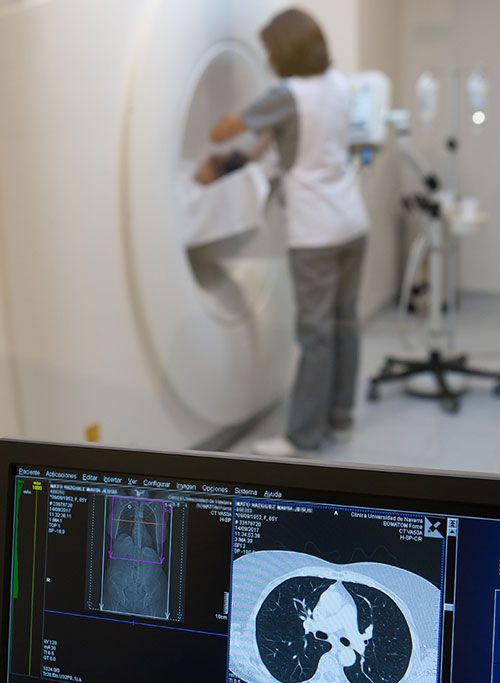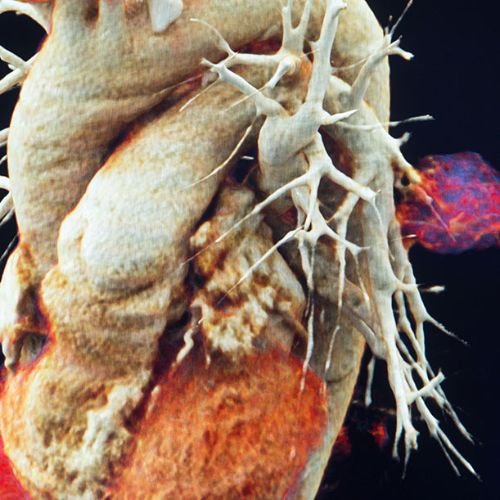Early Detection Program: Lung Cancer and Tobacco
Lung cancer is one of the most common cancers caused by tobacco.
Almost 20 years ago, the Clínica Universidad de Navarra implemented for the first time in Spain, the Early Detection of Lung Cancer Program, with the objective of reducing mortality and improving the survival of this type of tumor.
The Program includes the performance of an annual low-dose CT scan that allows the examination of the chest cavity to determine if there are pulmonary nodules and to detect tumors in the early stages.
In our annual low-dose radiation CT early detection program, 85% of lung cancers detected are in stage I, the earliest stage in which lung cancer can be safely cured by surgery.

Do you want to carry out this prevention program?
Request an appointment to be assessed by our specialists
Why at the Clínica Universidad de Navarra
Speed and accuracy
The diagnostic process integrates the molecular biology of the tumor to achieve the most complete diagnosis in the shortest time possible.
Early diagnosis
85% of lung tumors are diagnosed at an early stage, if an annual preventive CT scan is performed.
Multidisciplinary team
The specialists work in coordination for the most effective diagnosis and treatment.
Experience
The Clinic is a pioneer in the Lung Cancer Early Detection Program
Learn about the Lung Cancer Early Detection Program
What does it consist of?
Phase 1
- Consultation with the specialist in Pneumology.
- Low-dose radiation CT.
- Respiratory function tests.
- Blood analysis.
Phase 2
- Follow-up of patients with annual low radiation CT.
- Medical consultation.
- Functional respiratory tests.
Who is it aimed at?
The program is aimed at smokers and ex-smokers over the age of 40.
In addition, all patients diagnosed with emphysema and/or lung function disorders are also candidates for the Lung Cancer Early Detection Program.
Diagnosis and Treatment of Lung Cancer
at the Clinica Universidad de Navarra

To reach a diagnosis of lung cancer, it is necessary to perform some diagnostic imaging tests.
In addition, in most cases, it is necessary to perform endoscopic studies to take a sample of the tissue and analyze it.
Chest CT (scanner)
Approximately 40% of smokers and ex-smokers who have a chest CT have benign lung nodules.
PET
PET is useful in the detection of nodules equal to or greater than 10 mm.
Respiratory function tests
A series of tests evaluate the alteration of the respiratory system. These tests consist of: spirometry; plethysmography, diffusion capacity, arterial gasometry, 6-minute walking test and cardiopulmonary stress test.
Bronchoscopy
They are performed under sedation and do not require hospital admission. Bronchoscopy allows visualization of the airway and collection of samples of respiratory secretions, bronchial or lung tissue or mediastinal nodes.

Multidisciplinary therapeutic plan combining surgery, radiotherapy and chemotherapy
Surgical treatment:
Thoracoscopy, at an early stage, allows for less invasive surgery
When the tumor is confirmed and the disease is localized, a surgical approach is possible in a high percentage of cases. If the disease is disseminated, it is probably no longer possible to use surgery.
Chemotherapy:
There are two different treatments, depending on whether the carcinoma is microcytic or not, depending on whether it is more or less aggressive.
Radiotherapy:
85% of lung tumors are non-small cell carcinomas, in which radiotherapy is essential in their control.
The best professionals at your disposal
Formed by specialists in Pneumology, Medical Oncology, Radiation Oncology, Thoracic Surgery, Radiology, Nuclear Medicine, Pathological Anatomy and follow-up with specialized nurses.











































